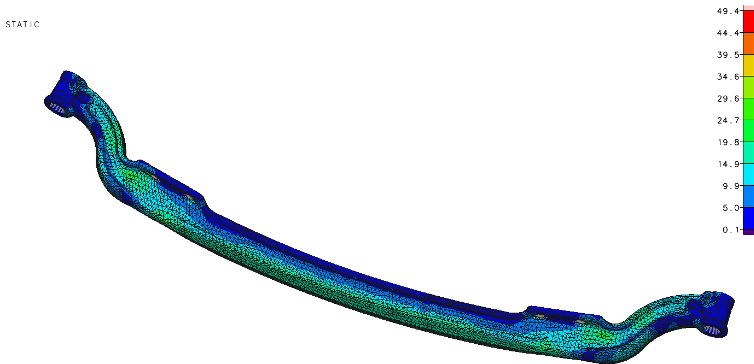Product = GENESIS
Introduction
Structural optimization is used to efficiently improve structures. Its usage requires the selection of two sets of quantities: Design variables and Responses. Design variables correspond to parameters that describe or define the structure, while responses correspond to quantities used to define the objective and the constraints of the problem. Responses can come from finite element analysis, geometry parameters, or a combination of the two.
In this blog we will describe some of the key responses available in the GENESIS structural analysis and optimization software.
Responses Available in GENESIS
Responses are quantities that are calculated by the program and are typically functions of the design variables. They can be used as the objective function or as constraints of the optimization problem. Understanding what responses are available allows the user to understand the power and the capabilities of the software. A summary of the responses available in GENESIS is presented next.
Finite Element Responses
Almost every finite element response calculated for analysis can be used in optimization. These responses are:
- Static responses: Displacements, stresses, strain forces, reaction forces and strain energy
- Heat transfer responses: Temperatures and heat compliance
- Stability analysis responses: Buckling load factors
- Vibration analysis responses: Natural frequencies and mode shape components
- Dynamic and Random responses: Displacements, velocities, accelerations; stresses, strains, forces and ERP (Equivalent Radiated Power)
- Acoustic responses: Acoustic pressures
- Fatigue responses: Stresses and strain responses
 Figure 1 – Stress Distribution
Figure 1 – Stress Distribution
Fig. 1 shows the stress distribution on a structural component. Any or all stress shown there can be used as a response to define constraints on an optimization problem.
Geometry Responses
Geometry Responses are responses that are functions of grid locations. Examples are: volumes, areas, lengths, angles, distances, moment of inertias and center of gravity.
 Figure 2 – Angle response
Figure 2 – Angle response
Fig. 2 shows an angle defined using 3 grids of a finite element mesh. This angle can be used as a response to define a constraint on a shape, topography, and/or freeform optimization problem.
Equation Responses
The user can specify nonlinear equations combining finite element responses, design variables, grid locations, and geometric responses to create their own responses.
 Figure 3 – User Equation
Figure 3 – User Equation
Fig. 3 shows a user equation including a Force F response and an area A of a bar. This equation response can be used as a response to prevent local buckling of a bar element on an optimization problem.
Shifted Responses
The user can specify a built-in equation that is a function of frequencies to scale, invert, offset, etc. and responses that themselves are a function of frequencies.
 Figure 4 – Shifted Response
Figure 4 – Shifted Response
Fig. 4 shows one of several optional shifted response equations available in GENESIS. The equation shown allows the user to scale by Coeff and to convert to Log Scale H(f)/Refval. In the above equation H(f) could be displacements, velocities, acceleration or other frequency dependent FEA responses and Refval is a real value supplied by the user. T(f) is a table value that is a function of frequencies.
Subroutine Responses
User-written subroutines can be linked with GENESIS to mix finite element responses, design variables, grid locations and geometric responses to create special responses.
External Responses
An external program can be called within GENESIS to generate responses from the external analysis programs for multidisciplinary optimization. Examples are: Non-Linear Displacement from LS-Dyna or Non-Linear stresses and strains from ANSYS.
Examples using Responses Available in GENESIS
Depending of what kind of structure is desired, the user can pick and choose one or more of the available responses as the objective and the additional responses as constraints. Here are some examples:
Lightest Structure Possible
The following formulation can be used:
 Figure 5 – Optimization Problem Statement to Obtain a Light Structure
Figure 5 – Optimization Problem Statement to Obtain a Light Structure
Stiffest Structure Possible
The following formulation can be used:
 Figure 6 – Optimization Problem Statement to Obtain a Stiff Structure
Figure 6 – Optimization Problem Statement to Obtain a Stiff Structure
Most Conductive Structure Possible
The following formulation can be used:
 Figure 7 – Optimization Problem Statement to Obtain a Conductive Structure
Figure 7 – Optimization Problem Statement to Obtain a Conductive Structure
Discussion and Summary
Responses in the GENESIS software are used to define the objectives and constraints in a structural optimization problem. The GENESIS user can choose from a large variety of responses and he/she can mix them in a single problem. The user can simultaneously use responses from static, dynamic, heat transfer, and/or other analysis types. These responses can be used on sizing, shape, topology, topometry, topography, and/or freeform optimization problems.